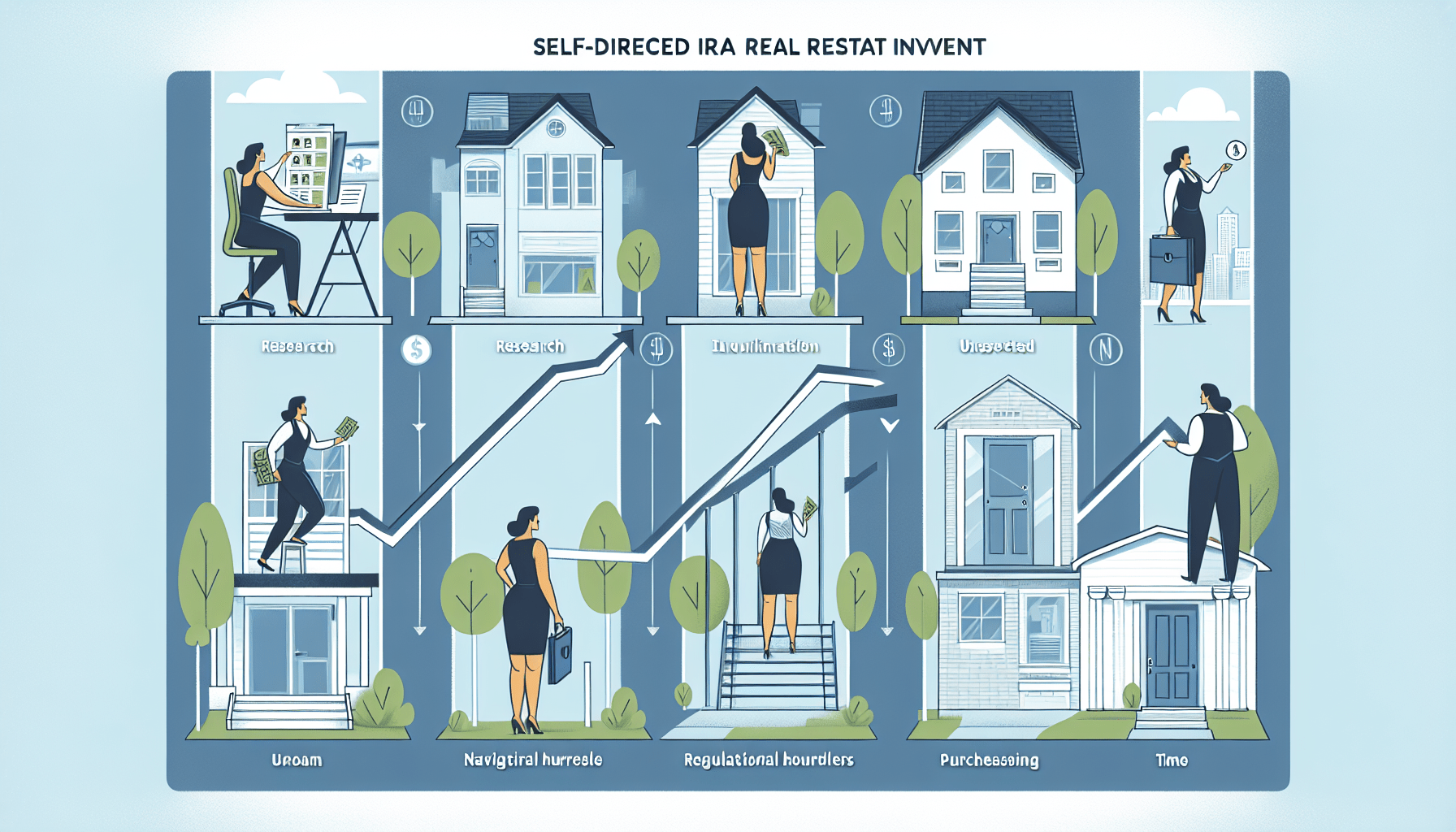Imagine being able to invest in real estate without using your own personal savings. With self-directed IRAs, this possibility becomes a reality. In this article, we will explore the ins and outs of financing a real estate investment through self-directed IRAs. Discover how this unique investment strategy offers individuals the opportunity to grow their wealth while enjoying the potential benefits of real estate. So sit back, relax, and let’s dive into the world of self-directed IRAs and real estate financing.
Choosing the Right Self-Directed IRA Custodian
When it comes to self-directed IRAs, choosing the right custodian is crucial. A custodian is a financial institution that holds your IRA assets and ensures that all transactions and investments are carried out according to IRS regulations. Researching potential custodians is the first step in this process.
Look for custodians who specialize in self-directed IRAs, as they will have a thorough understanding of the unique rules and regulations that govern these accounts. Consider factors such as their reputation, experience, and customer service. Reading reviews or seeking recommendations from other investors can help you gauge their reliability and professionalism.
Evaluate their fees and services
Different custodians charge different fees for their services, so it’s essential to evaluate these fees before making a decision. Some custodians may charge an account setup fee, annual fees, transaction fees, or custodial fees. Take the time to compare the fee structures of different custodians to ensure you find one that aligns with your financial goals and investment strategy.
Aside from fees, evaluate the services offered by each custodian. Some custodians may provide additional services like educational resources, investment advisory services, or property management assistance. Consider which services are important to you and choose a custodian that offers the right balance of services at a reasonable cost.
Review their investment options
One of the primary advantages of a self-directed IRA is the ability to invest in a wide range of assets, including real estate. However, not all custodians offer the same investment options. Some may specialize in real estate investments, while others may have a broader range of options.
Review the investment options provided by each custodian and ensure they align with your investment goals. Look for custodians who offer the flexibility to invest in different types of real estate, such as residential properties, commercial properties, or even vacant land. Additionally, consider whether the custodian allows for investments in alternative real estate assets like private equity or real estate investment trusts (REITs).
Understanding Self-Directed IRAs and Real Estate Investments
Before diving into real estate investments through self-directed IRAs, it’s essential to understand the basic concept of self-directed IRAs, as well as the rules and regulations that govern them. This knowledge will help you make informed decisions and navigate the investment process effectively.
Know the basic concept of self-directed IRAs
A self-directed IRA is an individual retirement account that allows you to have control over your investment choices beyond traditional stocks, bonds, and mutual funds. With a self-directed IRA, you have the flexibility to invest in alternative assets such as real estate, precious metals, private equity, and more.
Unlike traditional IRAs, self-directed IRAs require a custodian or trustee to hold and administer the investments on your behalf. The custodian ensures that all transactions and investments are in compliance with IRS regulations. It’s important to note that self-directed IRAs have the same tax advantages and contribution limits as traditional IRAs.
Understand the rules and regulations
Self-directed IRAs are subject to specific rules and regulations set forth by the IRS. It’s crucial to familiarize yourself with these rules to avoid any non-compliance issues. One important rule to note is the prohibited transaction rule. This rule prohibits certain transactions between the IRA and certain disqualified persons, such as yourself, your spouse, or certain family members.
Additionally, self-directed IRAs require careful record-keeping and reporting. You must properly document all transactions and keep them separate from your personal finances. Any income generated from the investments must be deposited back into the IRA. Failing to adhere to these rules can result in penalties and potential disqualification of the IRA’s tax advantages.
Learn about the benefits and limitations
Self-directed IRAs offer several benefits for investors looking to diversify their retirement portfolios. The ability to invest in real estate allows for potential appreciation, rental income, and portfolio diversification. Real estate can provide a hedge against inflation and offer more control over investments compared to traditional assets.
However, it’s essential to recognize the limitations of self-directed IRAs. Real estate investments are illiquid and may require locking up your funds for an extended period. Additionally, managing real estate investments can be time-consuming and may require expertise in property evaluation, tenant management, and market analysis. Understanding both the benefits and limitations of self-directed IRAs can help you make informed investment decisions.
Determining Eligible Real Estate Investments
Once you have a solid understanding of self-directed IRAs and the rules surrounding them, it’s time to determine what types of real estate investments are eligible within the scope of these accounts.
Identify permissible properties
The IRS allows self-directed IRAs to invest in a wide range of real estate properties, including residential properties, commercial properties, single-family homes, multi-unit buildings, and even undeveloped land. Understanding the permissible properties will give you the flexibility to explore various investment opportunities.
When identifying permissible properties, it’s important to conduct thorough due diligence. Consider factors such as location, market trends, rental potential, and potential for property appreciation. Having a clear investment plan and strategy can help you narrow down your options and determine which properties align with your goals.
Consider prohibited activities
While self-directed IRAs offer great flexibility, there are certain prohibited activities that you must be aware of. The IRS prohibits self-dealing, which means you cannot use the investment property for personal use or benefit. Additionally, you cannot engage in transactions with disqualified persons, such as yourself, family members, or certain business entities.
Understanding prohibited activities is crucial to avoid any potential penalties or disqualification of your self-directed IRA. Consulting with a tax professional or IRA custodian can help ensure that you stay in compliance with the IRS regulations.
Explore alternative options
In addition to traditional real estate properties, self-directed IRAs also allow for investments in alternative real estate assets. These assets include real estate investment trusts (REITs), private equity funds, mortgage notes, tax liens, and more. Exploring alternative options can provide additional diversification and potentially attractive investment opportunities.
When considering alternative options, evaluate the risks and rewards associated with each asset class. Conduct thorough research, review historical performance, and seek professional advice if needed. Diversifying your real estate investments can help minimize risk and maximize the potential for returns.
Funding the Self-Directed IRA for Real Estate Investment
Once you’ve chosen a suitable custodian and determined your eligible real estate investments, it’s time to fund your self-directed IRA. There are various ways to contribute to your IRA and ensure you have enough funds to finance your real estate investment.
Contribute to the IRA through various sources
One way to fund your self-directed IRA is through regular contributions. You can make annual contributions up to the IRA contribution limits set by the IRS. These limits are subject to change each year, so it’s important to stay updated on the current limits.
In addition to regular contributions, you may also consider making catch-up contributions if you’re age 50 or older. Catch-up contributions allow you to contribute an additional amount on top of the regular contribution limits.
Another way to fund your self-directed IRA is through rollovers or transfers from other retirement accounts. If you have funds in a traditional IRA, 401(k), or other eligible retirement accounts, you can transfer or rollover those funds into your self-directed IRA. This can help consolidate your retirement savings and provide more capital for real estate investments.
Consider rollovers and transfers
Rollovers and transfers allow you to move funds from one retirement account to another without incurring taxes or penalties. This can be particularly beneficial if you have funds in an employer-sponsored 401(k) that you want to transfer into your self-directed IRA.
When considering rollovers and transfers, consult with your custodian and tax advisor to ensure you follow the proper procedures and documentation requirements. Failing to follow the correct process can result in taxes or penalties that could eat into your investment capital.
Understand contribution limits and tax implications
It’s crucial to understand the contribution limits imposed by the IRS for self-directed IRAs. These limits may change each year and differ for different types of IRAs, such as traditional IRAs and Roth IRAs. Educate yourself about the current limits and ensure you comply with them to avoid any tax implications or penalties.
Additionally, it’s important to understand the tax implications of funding your self-directed IRA. Traditional IRA contributions are typically tax-deductible, while Roth IRA contributions are made with after-tax dollars. Consult with a tax professional to determine which type of IRA makes the most sense for your financial situation and investment strategy.
Selecting the Right Real Estate Investment
With your self-directed IRA funded and ready to go, it’s time to select the right real estate investment for your portfolio. This decision requires careful analysis and consideration of several factors.
Analyze potential returns and risks
When evaluating potential real estate investments, analyze the potential returns and risks associated with each property. Consider factors such as rental income, potential property appreciation, and market trends. Additionally, assess the risks involved, such as vacancy rates, maintenance costs, and potential regulatory changes.
Performing a thorough cost-benefit analysis can help you determine whether a particular investment aligns with your financial goals and risk tolerance. Consult with professionals or use online tools to help you analyze the potential returns and risks of different properties.
Consider diversification and asset allocation
Diversification is an essential aspect of any investment portfolio, and real estate investments in self-directed IRAs are no exception. Consider spreading your investments across different types of real estate properties or even different geographic locations. This can help mitigate risk and provide a more stable portfolio.
Additionally, consider your overall asset allocation and how real estate fits into your investment strategy. Balance your investments across different asset classes, such as stocks, bonds, and real estate. This can help ensure you have a well-diversified portfolio that aligns with your financial goals and risk tolerance.
Evaluate property management options
Investing in real estate through a self-directed IRA comes with the responsibility of managing the property. Depending on your expertise and availability, you may choose to manage the property yourself or hire a property management company.
If you decide to manage the property yourself, be prepared for the time commitment and responsibilities that come with it. This includes finding tenants, collecting rent, handling maintenance issues, and ensuring compliance with local regulations.
Alternatively, hiring a property management company can alleviate some of these responsibilities, but it comes with a cost. Evaluate the pros and cons of each option and choose the one that aligns with your capabilities and investment strategy.
Conducting Due Diligence
Before finalizing any real estate investment, it’s essential to conduct thorough due diligence. This involves assessing the investment property, performing market analysis, and reviewing financial projections.
Assess the investment property thoroughly
Take the time to inspect the investment property thoroughly. This includes evaluating the condition of the property, examining any necessary repairs or renovations, and considering any potential issues that may arise. This assessment will help you determine the true value of the property and identify any potential red flags.
Consider hiring a professional home inspector to conduct a comprehensive inspection. Their expertise can help identify any hidden issues or necessary repairs that may not be apparent to the untrained eye.
Perform market analysis and feasibility studies
Understanding the market dynamics of the area where the investment property is located is critical. Perform a market analysis to assess factors such as property value trends, rental demand, vacancy rates, and potential rental income.
Additionally, conduct feasibility studies to evaluate the viability of the investment. This includes analyzing the potential return on investment, considering financing options and associated costs, and assessing the overall risk and reward of the investment.
Review financial projections and past performance
Before making any investment decision, review the financial projections provided by the seller or conduct your own analysis. This includes evaluating potential rental income, operating expenses, and cash flow projections. Ensure that the numbers align with your investment goals and satisfy your expectations.
Furthermore, review the past performance of the investment property if available. Analyze rental history, vacancy rates, and any other relevant data to gain insights into the property’s performance. Past performance can provide valuable information when making investment decisions.
Structuring the Real Estate Investment
Once you have conducted thorough due diligence and are ready to proceed with the real estate investment, it’s important to consider the appropriate legal structure and financing options.
Choose the appropriate legal structure
Deciding on the legal structure of your real estate investment is an essential step. Common options include investing in your IRA’s name, setting up a limited liability company (LLC), or investing through a third-party structure such as a real estate partnership or syndication.
Consult with a legal professional well-versed in self-directed IRA investing to determine the best structure for your specific situation. Each structure has its own pros and cons, so be sure to consider factors such as liability protection, tax implications, and ease of management.
Consider the use of financing options
Financing your real estate investment can provide leverage and potentially increase your returns. While self-directed IRAs can use financing, there are specific rules and limitations to be aware of. For example, you cannot personally guarantee the loan on behalf of your IRA, and the loan must be non-recourse.
Research different financing options available for self-directed IRAs, such as non-recourse loans, private financing, or seller financing. Understand the terms and conditions associated with each option and consider the impact on your overall investment strategy and risk tolerance.
Evaluate partnership arrangements
Real estate investments can be structured as partnerships or syndications, allowing you to pool your funds with other investors to acquire larger properties or share the investment risk. Consider partnering with like-minded investors who share your investment goals and align with your risk tolerance.
Evaluate the partnership arrangement carefully, ensuring that the terms and conditions are fair and favorable for all parties involved. Have solid legal documentation in place and consult with legal and financial professionals to protect your interests.
Completing the Real Estate Transaction
Once you have structured your real estate investment and are ready to proceed, it’s time to complete the transaction. This involves engaging professional assistance, preparing necessary documentation, and ensuring compliance with legal and regulatory requirements.
Engage professional assistance
Completing a real estate transaction can involve various parties, such as real estate agents, attorneys, title companies, and inspectors. Engaging professional assistance in each respective area is crucial to ensure a smooth and legally compliant transaction.
Work with a real estate agent experienced in self-directed IRA transactions who can guide you through the process and help locate suitable investment properties. Additionally, consult with an attorney specializing in real estate transactions to review and prepare the necessary legal documentation. Finally, consider working with a qualified title company to handle the title search, title insurance, and closing process.
Prepare necessary documentation
Proper documentation is essential when completing a real estate transaction. Ensure that all necessary paperwork is prepared and reviewed by legal professionals. This includes purchase agreements, disclosure statements, lease agreements (if applicable), and any other documents required by local laws or regulations.
Be diligent in reviewing all documents before signing or committing to any agreements. Seek professional advice if needed to ensure you understand the terms and conditions and are protected as an investor.
Ensure compliance with legal and regulatory requirements
Compliance with legal and regulatory requirements is crucial in any real estate transaction. Familiarize yourself with local laws and regulations that govern real estate investments, including zoning laws, rental laws, and property tax regulations.
Additionally, ensure that all aspects of the transaction are in compliance with self-directed IRA regulations. Work closely with your custodian who will oversee the transaction and ensure all necessary steps are taken to maintain compliance.
Monitoring and Managing the Investment
Once the real estate transaction is complete and you become a property owner, it’s important to actively monitor and manage your investment to maximize its potential.
Stay updated on property performance
Regularly monitor the performance of your investment property. Keep track of rental income, expenses, and any maintenance or repairs that may be required. Stay updated on market trends and changes that may impact the property’s value or rental potential.
Consider working with a property management company if you don’t have the time or expertise to manage the property yourself. They can handle tenant screening, rent collections, property maintenance, and other day-to-day responsibilities, allowing you to focus on other aspects of your investment.
Keep track of income and expenses
Accurate record-keeping is essential when managing a real estate investment. Keep a detailed record of all income generated by the property and all expenses associated with its maintenance and operation. This includes records of rent payments, invoices for repairs or improvements, property tax payments, insurance premiums, and any other relevant financial transactions.
Maintaining proper records will help ensure tax compliance, allow for accurate financial reporting, and provide a clear picture of the investment’s profitability.
Consider potential modifications or divestment
Periodically review your real estate investment portfolio and consider potential modifications or divestment if needed. Analyze the property’s performance and determine whether any modifications or improvements would increase its value or rental potential.
Additionally, assess your overall investment strategy and goals. If the property no longer aligns with your investment objectives or if market conditions change significantly, it may be appropriate to divest the property and reinvest in other opportunities.
Consult with professionals and evaluate the potential benefits and costs of any modifications or divestments. Ensure that any decisions align with your long-term financial goals and risk tolerance.
Retirement Withdrawals and Tax Considerations
As you near retirement age, understanding the rules and implications of withdrawing funds from your self-directed IRA becomes crucial. Retirees must navigate the distribution rules and consider potential tax liabilities associated with their real estate investments.
Understand distribution rules and penalties
Upon reaching the age of 59 ½, you can start taking distributions from your self-directed IRA. It’s important to understand the distribution rules to avoid penalties or unexpected tax liabilities.
Distributions from traditional IRAs are subject to ordinary income tax. Each distribution is considered taxable income for the year it’s withdrawn. Failure to take the required minimum distributions (RMDs) once you reach the age of 72 can result in significant penalties.
On the other hand, distributions from Roth IRAs are generally tax-free, assuming the account has been open for at least five years and certain other requirements are met.
Calculate potential tax liabilities
Real estate investments within your self-directed IRA may have tax implications upon distribution. If your investment property generates rental income, this income will be considered taxable when distributed from your IRA. The tax rate on this income will depend on your individual tax bracket.
Consult with a tax professional to calculate the potential tax liabilities associated with your self-directed IRA and real estate investments. They can help ensure that you are adequately prepared for any taxes owed upon distribution.
Seek advice from tax professionals
Navigating the complex tax considerations associated with self-directed IRAs and real estate investments can be challenging. Seeking advice from tax professionals who specialize in self-directed IRAs is highly recommended.
Tax professionals can guide you through the process, help you assess potential tax liabilities, and develop a tax-efficient withdrawal strategy. They can also provide insights into any recent regulatory changes or new tax laws that may impact your retirement plan.
In conclusion, financing a real estate investment through self-directed IRAs requires careful consideration and thorough research. From choosing the right custodian to understanding the rules and regulations, to determining eligible investments and managing the investment, each step is essential for a successful real estate investment within an IRA. Seek professional advice when needed, stay updated on tax considerations, and always evaluate potential risks and returns before making any investment decisions. With careful planning and knowledgeable guidance, self-directed IRAs can be a valuable tool for financing real estate investments and achieving your retirement goals.





